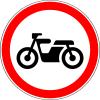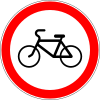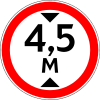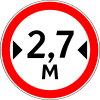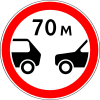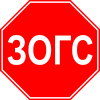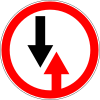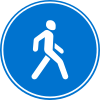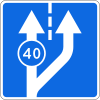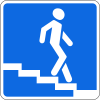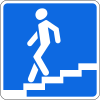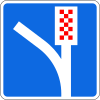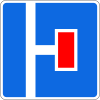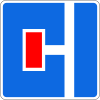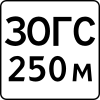
Road signs in Sweden are regulated in Vägmärkesförordningen, VMF (2007:90), and are to be placed 2 metres from the road with the sign 1.6 m from the base for motorized roads. Except for route numbers, there are a maximum of three signs on a pole, with the most important sign at the top. All signs have a reflective layer added on selected parts of the sign as is custom in European countries; most larger signs also have their own illumination.

European traffic signs present relevant differences between countries despite an apparent uniformity and standardisation. Most European countries refer to the 1968 Vienna Convention on Road Signs and Signals. The convention has been adopted by the following countries : Albania, Armenia, Austria, Belarus, Belgium, Bosnia and Herzegovina, Bulgaria, Croatia, Cyprus, the Czech Republic, Denmark, Estonia, Finland, France, Georgia, Germany, Greece, Hungary, Italy, Latvia, Liechtenstein, Lithuania, Luxembourg, Moldova, Montenegro, Netherlands, North Macedonia, Norway, Poland, Portugal, Romania, Russia, San Marino, Serbia, Slovakia, Slovenia, Spain, Sweden, Switzerland, Turkey, Ukraine and the United Kingdom. The convention has not been adopted by Ireland, Iceland or Malta.
Road signs in Ukraine are governed by a combination of standards set out by the Vienna Convention on Road Signs and Signals, the European Union (EU), and Ukraine Transport and Roads Agency. Ukrainian signs are similar to the signs of other post-Soviet states and are set out in 7 separate categories based on meaning: warning, priority, prohibitory, mandatory, information, service, and additional plates.
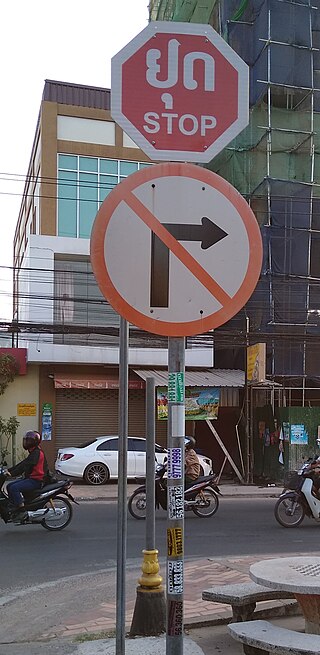
Road signs in Laos generally follow those used in most European countries as set out in the Vienna Convention on Road Signs and Signals. Despite this, the country itself has never signed the Vienna Convention on Road Signs and Signal. Inscriptions on traffic signs are in Lao, the national language of Laos. However, English is also used for stop and important public places such as tourist attractions, airports, railway stations, and immigration checkpoints. Both Lao and English are used on directional signage.

Road signs in Azerbaijan are similar to the road sign system of post-Soviet states that ensure that transport vehicles move safely and orderly, as well as to inform the participants of traffic built-in graphic icons. They generally conform to the Vienna Convention on Road Traffic and Vienna Convention on Road Signs and Signals.

Road signs in Armenia are similar to the signs of other post-Soviet states and most European road sign systems. Armenia is a signatory of the Vienna Convention on Road Traffic and the Vienna Convention on Road Signs and Signals. The Ministry of Transport regulates these icons, while the police enforces them. Road signs ensure transport vehicles move safely and orderly, as well as, to inform both pedestrians and motorists of traffic rules.

Road signs in Georgia are similar to the road sign system of other post-Soviet states that ensure that transport vehicles move safely and orderly, as well as to inform the participants of traffic built-in graphic icons. However, some road signs look a bit different from Soviet ones and closer to the European ones. These icons are governed by the Vienna Convention on Road Traffic and Vienna Convention on Road Signs and Signals.

Road signs in Kazakhstan are similar to the road sign system of other post-Soviet states that ensure that transport vehicles move safely and orderly, as well as to inform the participants of traffic built-in graphic icons. These icons are governed by the Vienna Convention on Road Traffic and Vienna Convention on Road Signs and Signals. Road signs are regulated by the СТ РК 1125-2021 standard.

Road signs in Kyrgyzstan are similar to the road sign system of other post-Soviet states that ensure that transport vehicles move safely and orderly, as well as to inform the participants of traffic built-in graphic icons. These icons are governed by the Vienna Convention on Road Traffic and Vienna Convention on Road Signs and Signals.

Road signs in Uzbekistan are regulated by the O'zDst 3283-2017 standard. Due to the country being a former Soviet Socialist Republic between 1924 and 1991, road signs are similar in design to those used in the Soviet Union before its dissolution in 1991, as well as in most other post-Soviet states. Uzbekistan acceded to the Vienna Convention on Road Signs and Signals on January 17, 1995. The Soviet Union itself was once a signatory to the Vienna Convention on Road Signs and Signals.

Road signs in Lithuania conform to the general pattern of those used in most other European countries as set out in the 1968 Vienna Convention on Road Signs and Signals. Due to the country being occupied and annexed by the Soviet Union between 1940 and 1990, when it restored its independence, modern road signs used in Lithuania are in many ways similar in design to road signs used in the Soviet Union before its dissolution in 1991. This design of road signs is still used in most post-Soviet states, in particular Russia, Belarus, and Ukraine. Neighboring post-Soviet Baltic countries Latvia and Estonia, which were also occupied by the Soviet Union in 1940, have significantly modified their road sign designs, resulting road signs in these two countries being extremely different in design from road signs used in most other post-Soviet states.

Road signs in Russia are governed by the traffic rules approved by the Decree of the Government of the Russian Federation No. 1090 of 23 October 1993 “On the Rules of the Road”, Appendix 1 “Road Signs”. They are regulated by the ГОСТ Р 52289-2019 and ГОСТ Р 52290-2004 standards determining the rules for the use and production of road signs. The vast majority of road signs used in Russia were in the preceding Soviet standard ГОСТ 10807-78, which was introduced in the Soviet Union on 1 January 1980 before its dissolution in 1991 and is no longer valid in Russia since 1 January 2006 after it was replaced by the modern standard ГОСТ Р 52290-2004 for road signs. Road signs generally conform to the Vienna Convention on Road Signs and Signals. Similar road signs are also used in other post-Soviet states.
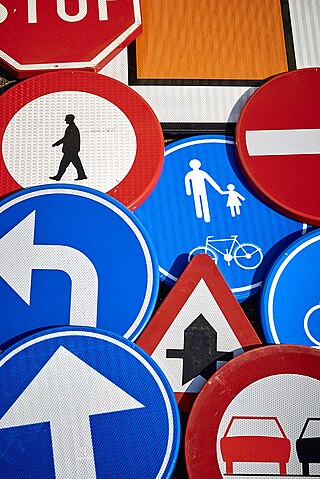
Road signs in Belgium are defined in the Royal Decree of 1 December 1975 on general regulations for the road traffic police and in the use of public highways. They generally conform to the 1968 Vienna Convention on Road Signs and Signals. The official typeface on road signs in Belgium is SNV.

Road signs in Portugal are governed by the "Regulamento de Sinalização do Trânsito" of the Republic of Portugal.
Road signs in Latvia conform to the general pattern of those used in most other European countries. They are regulated in Ceļu satiksmes noteikumi and the standards documents LVS 77–1:2016 "Ceļa zīmes. 1. daļa: Ceļa zīmes", LVS 77-2:2016 "Ceļa zīmes. 2. daļa: Uzstādīšanas noteikumi" and LVS 77-3:2016 "Ceļa zīmes. 3. daļa: Tehniskās prasības" in conformity with the 1968 Vienna Convention on Road Signs and Signals. Latvia acceded to the Vienna Convention on Road Signs and Signals on October 19, 1992.
The road signs in the post-Soviet states Armenia, Azerbaijan, Belarus, Estonia, Georgia, Kazakhstan, Kyrgyzstan, Latvia, Lithuania, Moldova, Russia, Tajikistan, Turkmenistan, Ukraine and Uzbekistan are largely similar to the Soviet road sign system, as these countries were part of the Soviet Union until its dissolution in 1991. However, in some countries of the former USSR, some road signs may look different from the Soviet ones. The Soviet Union was a signatory to the 1968 Vienna Convention on Road Signs and Signals. After the dissolution of the Soviet Union in 1991, most of the post-Soviet states adopted their own road sign standards. Many of them use road sign systems that inherited the road sign system used in the Soviet Union before 1991, but with some modifications, except for Estonia and Latvia that use completely different road sign systems. Estonia and Latvia have their own road sign systems, which are very different in design from the Soviet one. Modern road signs in Armenia, Azerbaijan, Belarus, Estonia, Georgia, Kazakhstan, Kyrgyzstan, Latvia, Lithuania, Moldova, Russia, Tajikistan, Turkmenistan, Ukraine and Uzbekistan comply with the Vienna Convention on Road Signs and Signals as well as most European countries. Of the 15 former post-Soviet states, only Belarus, Russia and Ukraine have signed and ratified the Vienna Convention on Road Signs and Signals on behalf of the Soviet socialist republics. These 3 countries have ratified this convention on June 18, 1974.

Road signs in Tajikistan are similar to the signs of other post-Soviet states and most European road sign systems. Like all post-Soviet states, Tajikistan is a signatory to the Vienna Convention on Road Traffic and the Vienna Convention on Road Signs and Signals. Order of the Government of the Republic of Tajikistan of June 29, 2017 No. 323 "About Traffic regulations" regulates road signs and markings. Road signs ensure transport vehicles move safely and orderly, as well as, to inform both pedestrians and motorists of traffic rules. Images of road signs are mostly based on the Soviet ГОСТ 10807-78, Belarusian СТБ 1140-2013 and Russian ГОСТ Р 52290-2004 standards.

Road signs in Turkmenistan are similar to the road sign system of other post-Soviet states that ensure that transport vehicles move safely and orderly, as well as to inform the participants of traffic built-in graphic icons. They generally conform to the Vienna Convention on Road Signs and Signals. Turkmenistan acceded to the Vienna Convention on Road Signs and Signals on June 14, 1993.

Road signs in Belarus are regulated by the СТБ 1140-2013 standard. Due to the country being a former Soviet Socialist Republic between 1920 and 1991, road signs are similar in design to those used in the Soviet Union before its dissolution in 1991, as well as in most other post-Soviet states, especially neighboring Russia and Ukraine. Like Russia and Ukraine, Belarus is a signatory to the Vienna Convention on Road Traffic and the Vienna Convention on Road Signs and Signals. Belarus signed the Vienna Convention on 8 November 1968 and ratified it on 18 June 1974, when it was a Soviet Socialist Republic. The Soviet Union itself was once a signatory to the Vienna Convention on Road Signs and Signals.

Road signs in the Soviet Union were regulated in the ГОСТ 10807-78 standard which was introduced on 1 January 1980. This standard also specified the typeface used on road signs. After the dissolution of the Soviet Union in 1991, this standard continued to apply in all countries that were formerly Soviet republics until some of them adopted their own national standards for road signs. The shapes and colors of road signs in the Soviet Union, and now in all post-Soviet states, fully comply with the 1968 Vienna Convention on Road Signs and Signals, to which the Soviet Union was originally a signatory. On 8 November 1968, the Soviet Union signed the Vienna Convention on Road Signs and Signals, and on 7 June 1974 ratified it with some declarations and reservations made upon ratification.













































